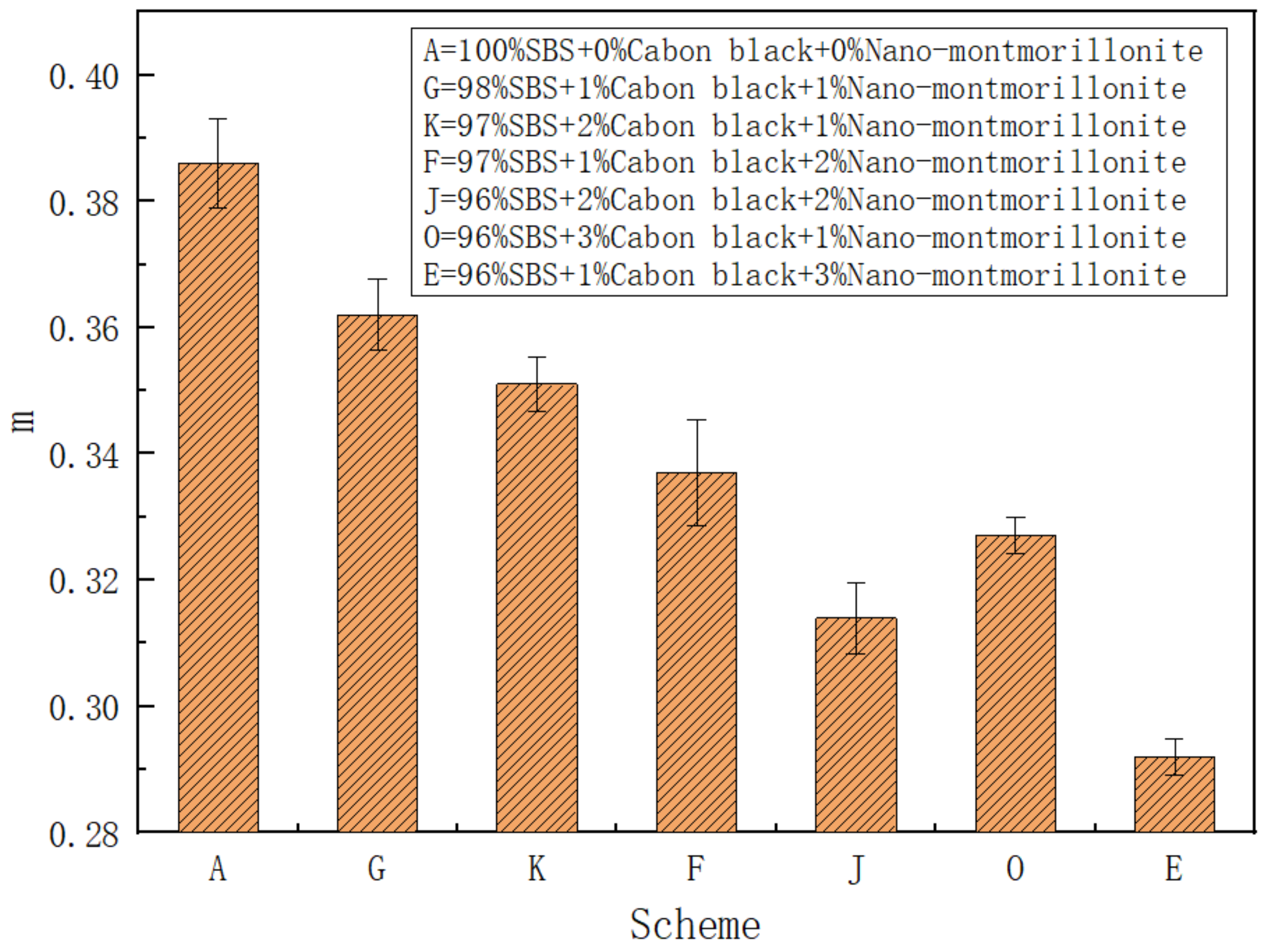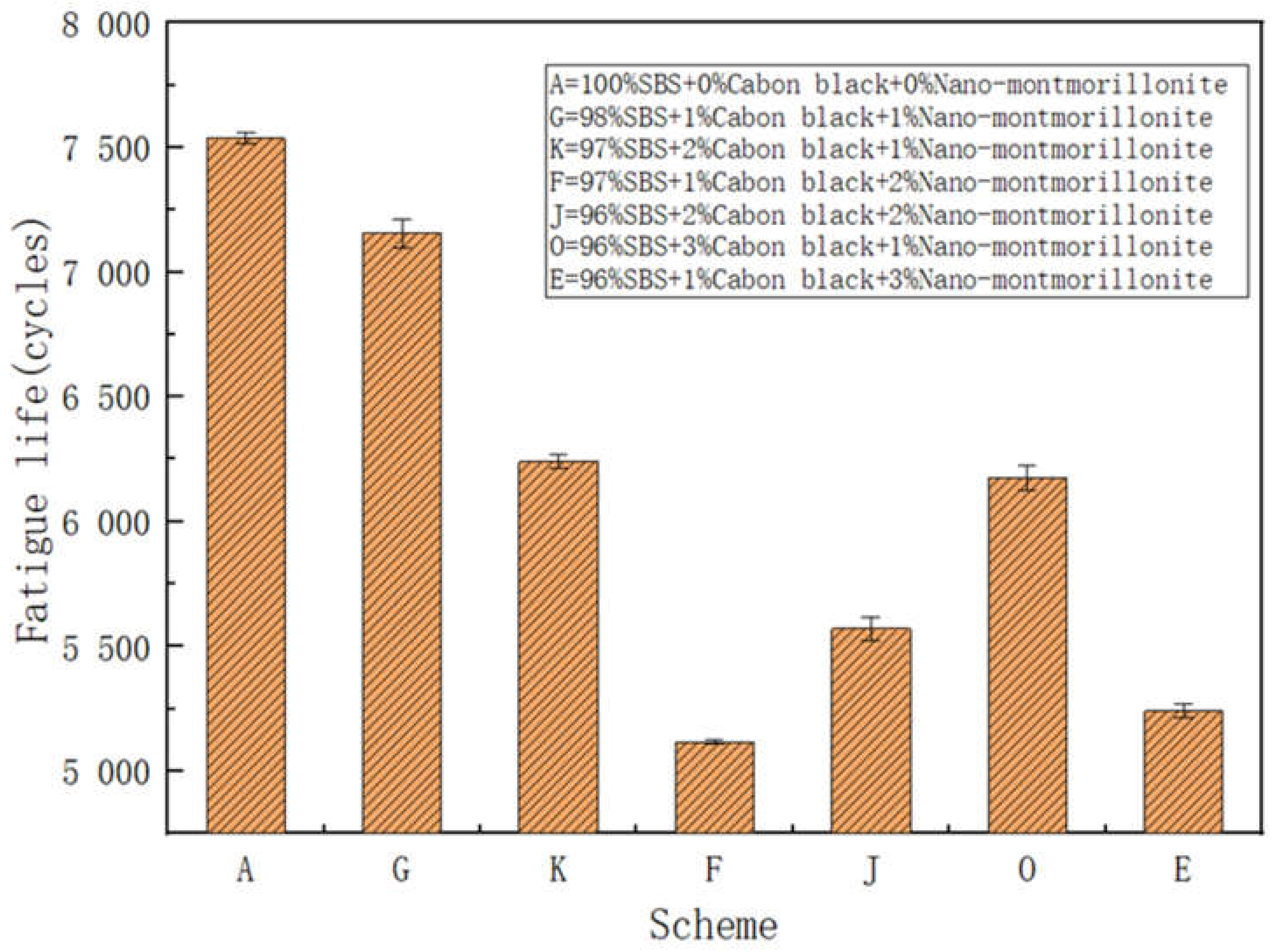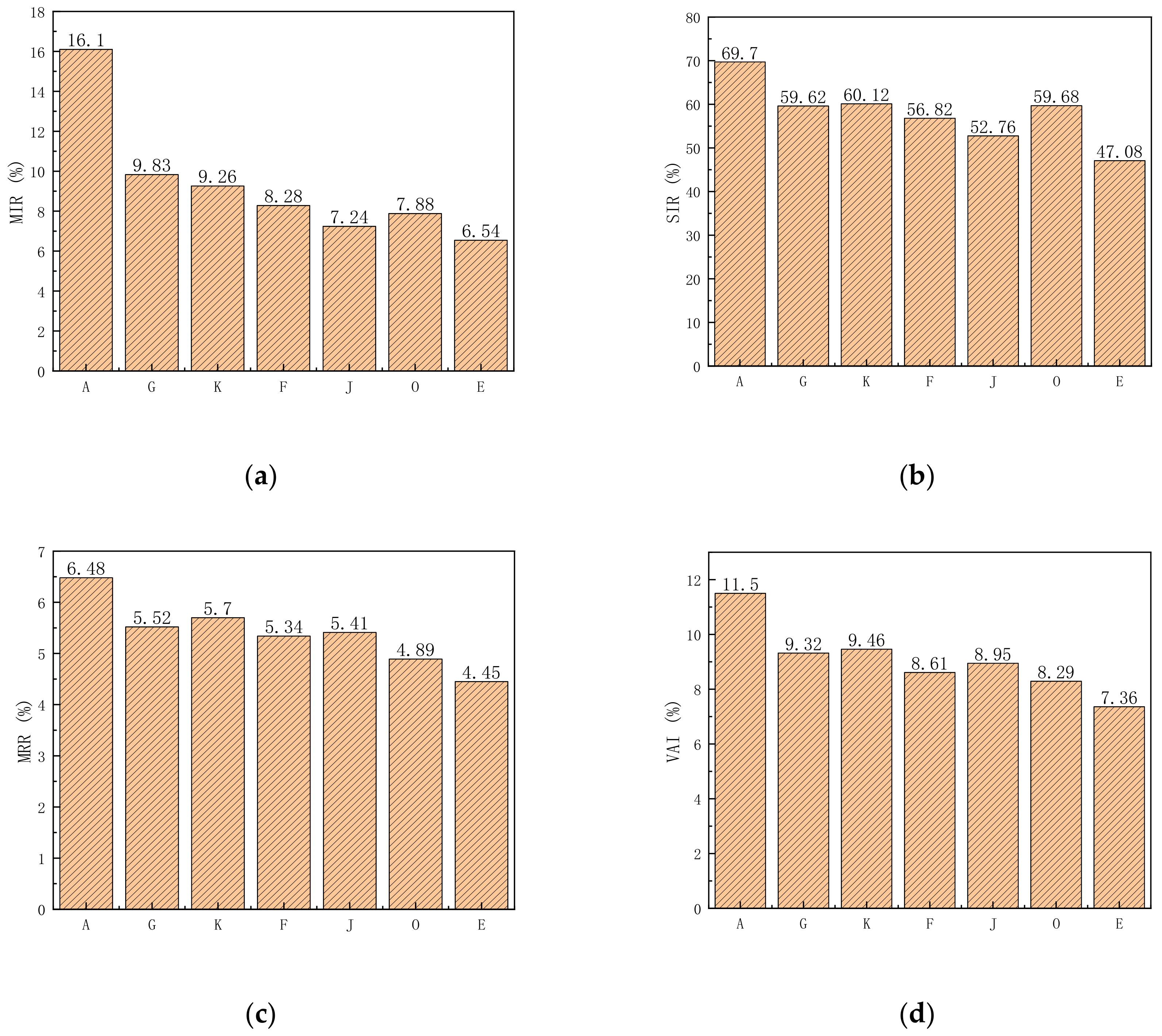Preparation and Performance Test of UV Resistant Composite-Modified Asphalt
Abstract
:1. Introduction
2. Materials and Methods
2.1. Materials
2.1.1. SBS-Modified Asphalt
2.1.2. Carbon Black
2.1.3. Nano-Montmorillonite
2.2. Sample Preparation
2.3. Orthogonal Experimental Design
2.4. Test Methods
3. Results
3.1. Optimization of UV Resistant Composite-Modified Asphalt Formula
3.2. Performance of UV Resistant Composite-Modified Asphalt
3.2.1. High-Temperature Performance
3.2.2. Low-Temperature Performance
3.2.3. Fatigue Performance
3.2.4. UV Aging Resistance
- is the complex shear modulus of the original asphalt;
- is the complex shear modulus of the aged asphalt.
- is the creep stiffness of the original asphalt;
- is the creep stiffness of the aged asphalt.
- is the creep rate of the aged asphalt;
- is the creep rate of the original asphalt.
- is the apparent viscosity (135 °C) of the aged asphalt;
- is the apparent viscosity (135 °C) of the original asphalt.
4. Conclusions
- (1).
- Nano-montmorillonite and carbon black are beneficial to the high-temperature performance and UV aging resistance of the composite-modified asphalt, but unfavorable to its low-temperature performance and fatigue performance. The total amount should be controlled to be within 4%. Nano-montmorillonite has a better ability to improve the high-temperature and anti-ultraviolet aging performance than carbon black and is also less favorable to the low-temperature and fatigue performance. It is recommended that its amount should not exceed 3%.
- (2).
- Based on factors such as the performance and prices of nano-montmorillonite, carbon black, and SBS composite-modified asphalt, Schemes G, J, K, and O provide the best performance.
- (3).
- Compared with SBS-modified asphalt, UV resistant composite-modified asphalt has obvious advantages in high-temperature performance and UV aging resistance, and its low-temperature performance meets the use requirements of the western plateau and other strong-UV areas.
Author Contributions
Funding
Institutional Review Board Statement
Informed Consent Statement
Data Availability Statement
Acknowledgments
Conflicts of Interest
References
- Giunta, M.; Pisano, A. One-Dimensional Visco-Elastoplastic Constitutive Model for Asphalt Concrete. Multidiscip. Model. Mater. Struct. 2006, 2, 247–264. [Google Scholar] [CrossRef]
- Zhu, J.; Birgisson, B.; Kringos, N. Polymer modification of bitumen: Advances and challenges. Eur. Polym. J. 2014, 54, 18–38. [Google Scholar] [CrossRef] [Green Version]
- Celauro, C.; Saroufim, E.; Mistretta, M.C.; La Mantia, F.P. Influence of Short-Term Aging on Mechanical Properties and Morphology of Polymer-Modified Bitumen with Recycled Plastics from Waste Materials. Polymers 2020, 12, 1985. [Google Scholar] [CrossRef]
- Sun, G.; Li, B.; Sun, D.; Yu, F.; Hu, M. Chemo-rheological and morphology evolution of polymer modified bitumens under thermal oxidative and all-weather aging. Fuel 2021, 285, 118989. [Google Scholar] [CrossRef]
- Joohari, I.; Maniam, S.; Giustozzi, F. Effect of Long-Term Aging on Polymer Degradation and Fatigue Resistance of Hybrid Polymer-Modified Bitumen. J. Mater. Civ. Eng. 2022, 34, 04022286. [Google Scholar] [CrossRef]
- Yusoff, N.; Alhamali, D.I.; Ibrahim, A.; Rosyidi, S.; Hassan, N.A. Engineering characteristics of nanosilica/polymer-modified bitumen and predicting their rheological properties using multilayer perceptron neural network model. Constr. Build. Mater. 2019, 204, 781–799. [Google Scholar] [CrossRef]
- Joohari, I.B.; Giustozzi, F. Oscillatory shear rheometry of hybrid polymer-modified bitumen using multiple stress creep and recovery and linear amplitude sweep tests. Constr. Build. Mater. 2022, 315, 125791. [Google Scholar] [CrossRef]
- Sun, G.; Ma, J.; Sun, D.; Li, B.; Ling, S.; Lu, T. Influence of thermal oxidative aging on temperature induced self-healing transition of polymer modified bitumens. Mater. Des. 2020, 192, 108717. [Google Scholar] [CrossRef]
- Tian, Y.; Li, H.; Sun, L.; Zhang, H.; Harvey, J.; Yang, J.; Yang, B.; Zuo, X. Laboratory investigation on rheological, chemical and morphological evolution of high content polymer modified bitumen under long-term thermal oxidative aging. Constr. Build. Mater. 2021, 303, 124565. [Google Scholar] [CrossRef]
- Kleizienė, R.; Panasenkienė, M.; Zofka, A.; Vaitkus, A. Nanobased rejuvenators for polymer-modified bitumen under long-term ageing conditions. Constr. Build. Mater. 2022, 341, 127474. [Google Scholar] [CrossRef]
- Cong, P.; Xu, P.; Chen, S. Effects of carbon black on the anti aging, rheological and conductive properties of SBS/asphalt/carbon black composites. Constr. Build. Mater. 2014, 52, 306–313. [Google Scholar] [CrossRef]
- Yu, H.; Meng, X.; Gan, X.; Li, C.; Gan, Y. Experimental study on the first engineering process of pyrolysis carbon black modified asphalt surface layer of waste tire by dry casting method. Highway 2022, 67, 7–15. [Google Scholar]
- Meng, X.; Gan, X.; Gan, Y. Bloomberg Indoor preparation process parameters and road performance test and evaluation of asphalt mixture modified by pyrolysis carbon black of dry waste tire. Highway 2022, 67, 62–70. [Google Scholar]
- Li, Y.; Chen, H.; Li, C.; Song, W. Indoor test study on the performance of waste tire pyrolysis carbon black modified asphalt. Sino Foreign Highw. 2021, 41, 296–301. [Google Scholar] [CrossRef]
- Zhang, W.; Yuan, Z. Influence of white carbon black on SBS-modified asphalt and asphalt mixture performance. J. Shandong Univ. Technol. Nat. Sci. Ed. 2019, 33, 1–4. [Google Scholar] [CrossRef]
- Fa, C. Study on the Aging Resistance of Graphene Oxide/SBS Composite and Its Modified Asphalt; Chang’an University: Xi’an, China, 2021. [Google Scholar] [CrossRef]
- Lu, Y.; Yu, L.; Yang, J.; Zeng, W.; Lu, J. Preparation and performance of Hydrotalcite/waste rubber powder composite modified asphalt. Pet. Refin. Chem. Ind. 2020, 51, 81–86. [Google Scholar]
- Sui, N.; Lang, J. Effect of nanocomposites on thermal and UV aging properties of SBS-modified asphalt. J. Wuhan Univ. Technol. Traffic Sci. Eng. Ed. 2022, 46, 319–322, 329. [Google Scholar]
- Liao, M.; Liu, Z.; Gao, Y.; Liu, L.; Xiang, S. Study on UV aging resistance of nano-TiO2/montmorillonite/styrene-butadiene rubber composite modified asphalt based on rheological and microscopic properties. Constr. Build. Mater. 2021, 301, 124108. [Google Scholar] [CrossRef]
- Ameli, A.; Babagoli, R.; Khabooshani, M.; AliAsgari, R.; Jalali, F. Permanent deformation performance of binders and stone mastic asphalt mixtures modified by SBS/montmorillonite nanocomposite. Constr. Build. Mater. 2020, 239, 117700. [Google Scholar] [CrossRef]
- Yang, X.; Shen, A.; Jiang, Y.; Meng, Y.; Wu, H. Properties and mechanism of flame retardance and smoke suppression in asphalt binder containing organic montmorillonite. Constr. Build. Mater. 2021, 302, 124148. [Google Scholar] [CrossRef]
- Ye, F.; Yin, W.; Lu, H.; Dong, Y. Property improvement of Nano-Montmorillonite/SBS modified asphalt binder by naphthenic oil. Constr. Build. Mater. 2020, 243, 118200. [Google Scholar] [CrossRef]
- JTG F40-2004; Technical Specification for Construction of Highway Asphalt Pavement. People’s Communications Press: Beijing, China, 2004.
- JTG E20-2011; Test Code for Asphalt and Asphalt Mixture of Highway Engineering. People’s Communications Press: Beijing, China, 2011.
- Ren, Z.; Li, Y. Study on the influence of montmorillonite on the aging resistance of asphalt. Highway 2022, 67, 24–31. [Google Scholar]
- Wang, X.; Zhang, J.; Xiao, W. Preparation and performance of sodium montmorillonite modified asphalt. Highway 2012, 10, 130–133. [Google Scholar]
- Zhu, S.; Liu, D.; Xue, Y. Study on low temperature cracking resistance of montmorillonite modified asphalt mixture. Highway 2007, 9, 150–152. [Google Scholar]
- Yang, G.; Wang, X.; Shi, J. Evaluation of fatigue resistance of hard asphalt mixtures based on dissipative energy method. J. Build. Mater. 2018, 21, 913–919, 925. [Google Scholar]
- Meng, Y.; Zhang, X. Fatigue performance of modified asphalt based on cumulative dissipated energy ratio. J. South China Univ. Technol. Nat. Sci. Ed. 2012, 40, 99–103. [Google Scholar]
- Zhang, H.; Xu, G.; Chen, X.; Wang, R.; Zhou, W. Study on fatigue performance of aging asphalt with different test methods. J. Build. Mater. 2020, 23, 168–175. [Google Scholar]










| Property | Specification | Measured Value |
|---|---|---|
| Penetration (25 °C) (0.1 mm) | 40–60 | 54 |
| Penetration index | ≥0 | 0.6 |
| Softening point (°C) | ≥60 | 75.2 |
| Ductility (5 °C) (cm) | ≥20 | 33 |
| Apparent viscosity (135 °C) (Pa·s) | ≤3 | 1.975 |
| Recovery elastic (RE) (%) | ≥75 | 90 |
| Flash point (°C) | ≥230 | 280 |
| Storage stability (segregation, 48 h softening point difference) (°C) | ≤2.5 | 0.3 |
| Mass loss (%) | −1.0–1.0 | −0.070 |
| Penetration ratio (%) | ≥65 | 86 |
| Ductility (5 °C) (cm) | ≥15 | 21 |
| Performance grade | / | PG76-22 |
| Property | Specification | Property |
|---|---|---|
| Ash content (%) | ≤18.5 | 13.2 |
| Oil absorption value (mL/100 g) | ≥7.0 | 11.5 |
| Sieve residue (%) | / | 0.008 |
| Fineness (μm) | / | 10 |
| Moisture (%) | ≤3.0 | 0.5 |
| Specific surface area (m2/g) | / | 120 |
| pH | ≥6.0 | 7 |
| Property | Measured Value |
|---|---|
| Appearance (color) | White powder |
| Particle size (200 mesh pass rate) (%) | 97.5 |
| Density (g/cm3) | 1.8 |
| Montmorillonite content (%) | ≥95 |
| pH | 8.0 |
| Recipe | SBS-Modified Asphalt (%) | Carbon Black (%) | Nano-Montmorillonite (%) |
|---|---|---|---|
| A | 100 | 0 | 0 |
| B | 99 | 0 | 1 |
| C | 98 | 0 | 2 |
| D | 97 | 0 | 3 |
| E | 96 | 1 | 3 |
| F | 97 | 1 | 2 |
| G | 98 | 1 | 1 |
| H | 99 | 1 | 0 |
| I | 95 | 2 | 3 |
| J | 96 | 2 | 2 |
| K | 97 | 2 | 1 |
| L | 98 | 2 | 0 |
| M | 94 | 3 | 3 |
| N | 95 | 3 | 2 |
| O | 96 | 3 | 1 |
| P | 97 | 3 | 0 |
| Recipe | Softening Point (°C) | Apparent Viscosity (135 °C) (Pa·s) | Ductility (5 °C) (cm) |
|---|---|---|---|
| E | 86.4 | 3.94 | 22 |
| F | 84.2 | 3.37 | 26 |
| G | 81.3 | 2.79 | 27 |
| I | 87.3 | 4.03 | 21 |
| J | 86.1 | 3.91 | 23 |
| K | 82.2 | 3.17 | 25 |
| M | 89.4 | 4.23 | 18 |
| N | 86.8 | 3.95 | 19 |
| O | 82.9 | 3.62 | 22 |
Disclaimer/Publisher’s Note: The statements, opinions and data contained in all publications are solely those of the individual author(s) and contributor(s) and not of MDPI and/or the editor(s). MDPI and/or the editor(s) disclaim responsibility for any injury to people or property resulting from any ideas, methods, instructions or products referred to in the content. |
© 2023 by the authors. Licensee MDPI, Basel, Switzerland. This article is an open access article distributed under the terms and conditions of the Creative Commons Attribution (CC BY) license (https://creativecommons.org/licenses/by/4.0/).
Share and Cite
Shen, Q.; Ma, S.; Yang, Y.; Fan, L.; Li, Y.; Zhao, P. Preparation and Performance Test of UV Resistant Composite-Modified Asphalt. Coatings 2023, 13, 239. https://doi.org/10.3390/coatings13020239
Shen Q, Ma S, Yang Y, Fan L, Li Y, Zhao P. Preparation and Performance Test of UV Resistant Composite-Modified Asphalt. Coatings. 2023; 13(2):239. https://doi.org/10.3390/coatings13020239
Chicago/Turabian StyleShen, Quanjun, Shijie Ma, Yaohui Yang, Liang Fan, Yongzhen Li, and Pinhui Zhao. 2023. "Preparation and Performance Test of UV Resistant Composite-Modified Asphalt" Coatings 13, no. 2: 239. https://doi.org/10.3390/coatings13020239






